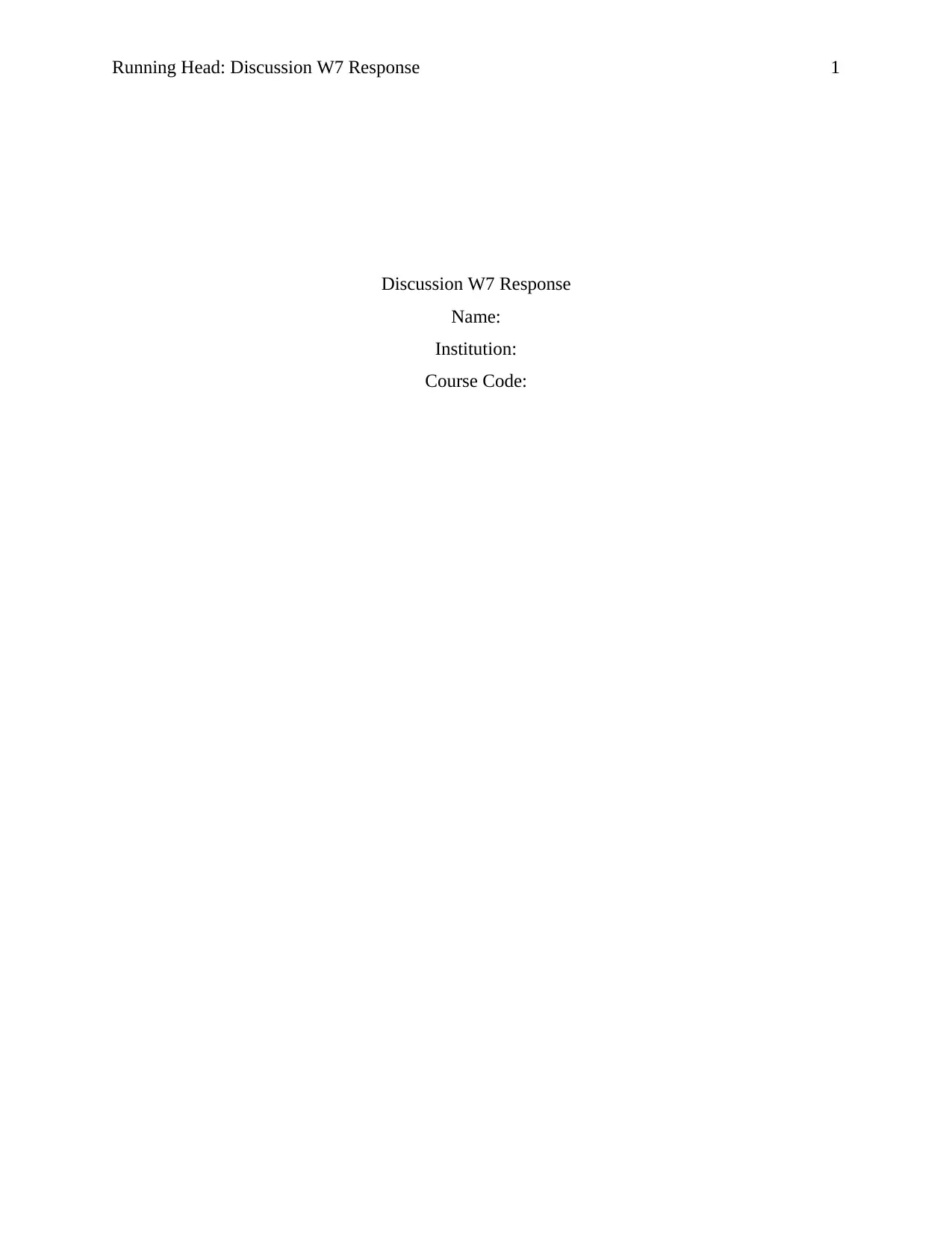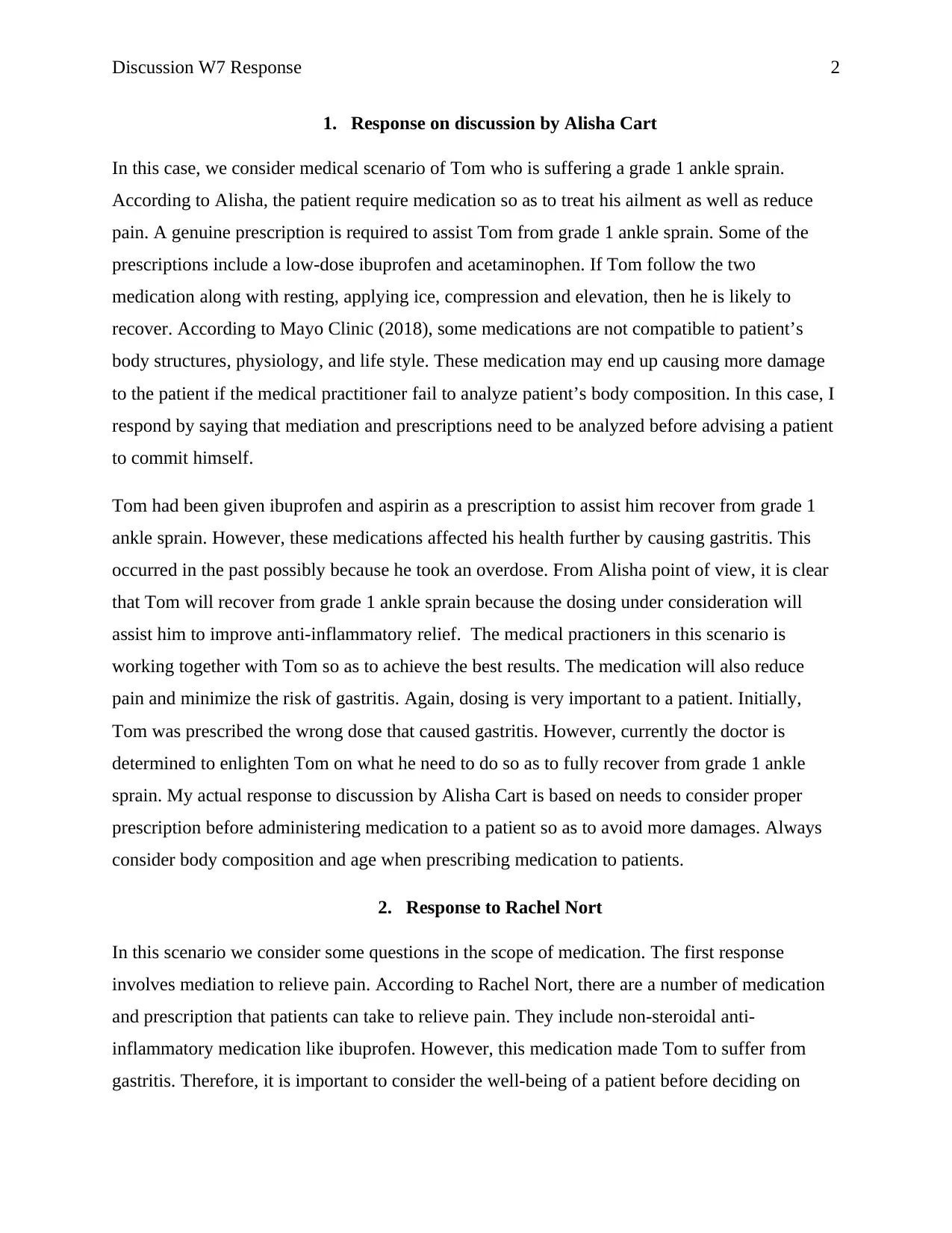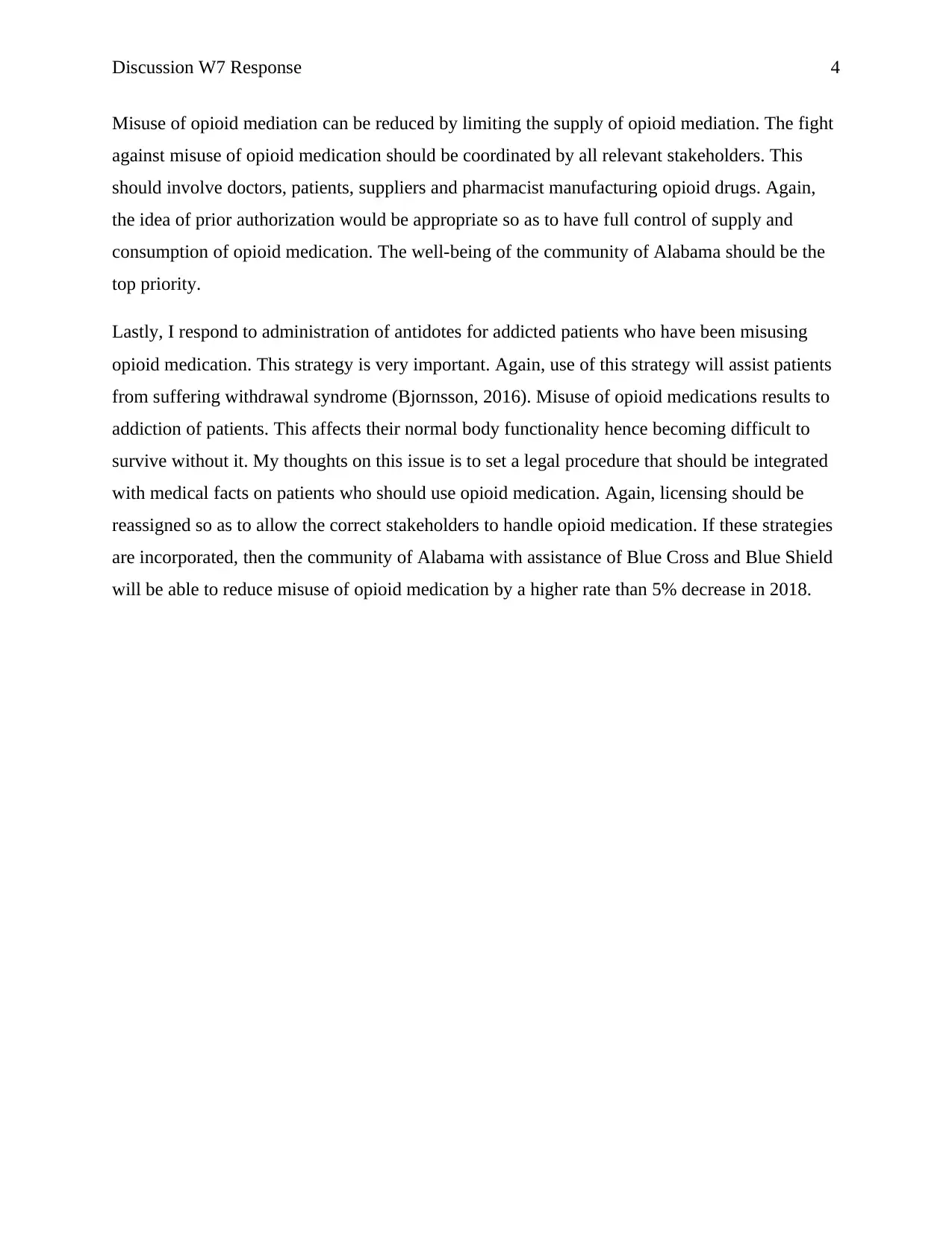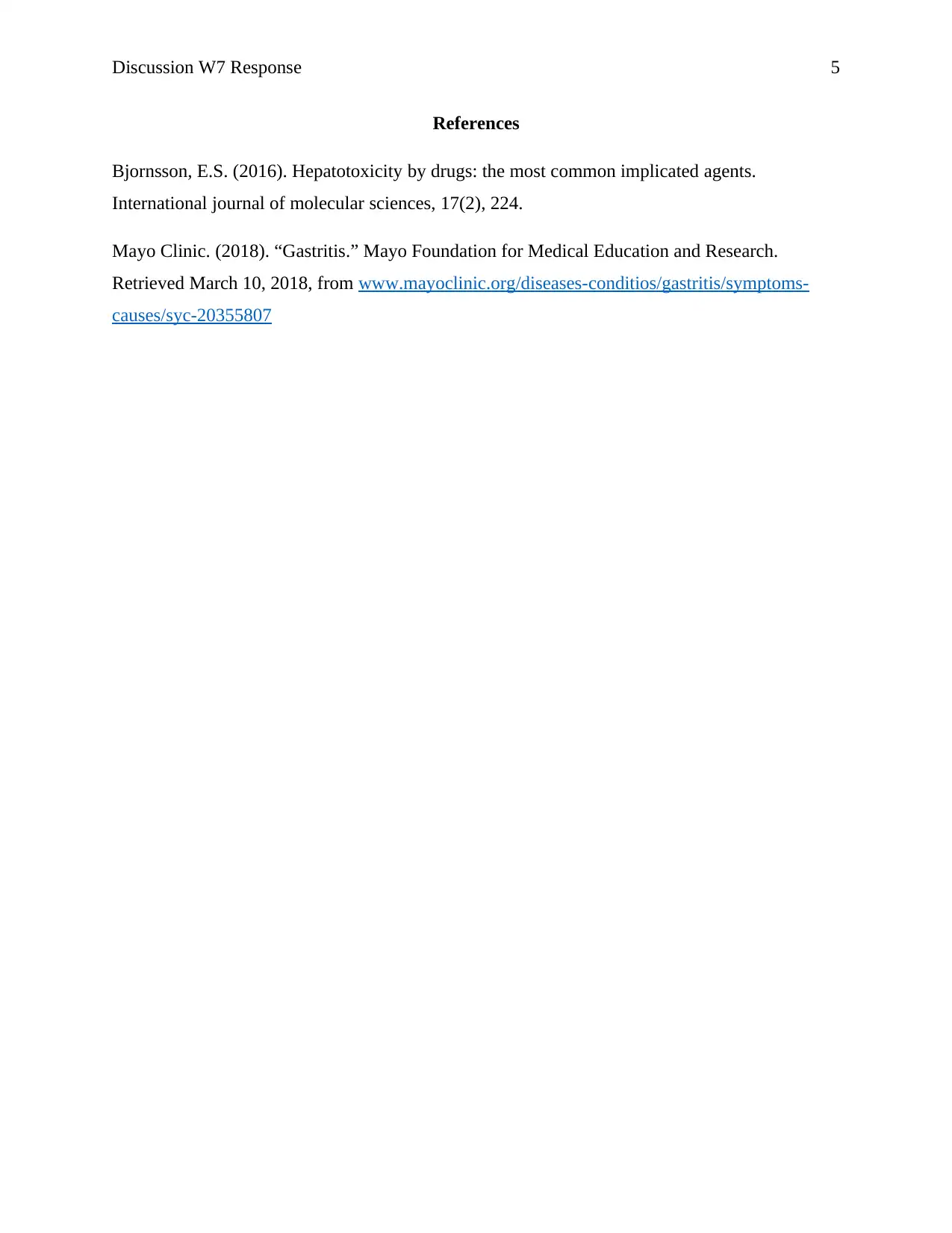Discussion W7 Response: Medication, Pain Relief, and Opioid Management
VerifiedAdded on 2021/04/19
|5
|1210
|73
Discussion Board Post
AI Summary
This discussion board post presents a student's responses to a medical scenario involving a grade 1 ankle sprain. The student analyzes the case of Tom, who requires medication for his condition, and discusses the importance of proper prescriptions, considering body composition and age to avoid adverse effects like gastritis. The post also addresses pain relief methods, comparing medication with natural approaches, and highlights the significance of monitoring patients and educating them on potential side effects. Furthermore, the student shares their thoughts on a new Blue Cross of Alabama initiative for opioid management, supporting measures to reduce opioid misuse through supply limitations, prior authorization, and the administration of antidotes for addicted patients, emphasizing the need for legal procedures and licensed stakeholders to ensure effective control and community well-being.

Running Head: Discussion W7 Response 1
Discussion W7 Response
Name:
Institution:
Course Code:
Discussion W7 Response
Name:
Institution:
Course Code:
Paraphrase This Document
Need a fresh take? Get an instant paraphrase of this document with our AI Paraphraser

Discussion W7 Response 2
1. Response on discussion by Alisha Cart
In this case, we consider medical scenario of Tom who is suffering a grade 1 ankle sprain.
According to Alisha, the patient require medication so as to treat his ailment as well as reduce
pain. A genuine prescription is required to assist Tom from grade 1 ankle sprain. Some of the
prescriptions include a low-dose ibuprofen and acetaminophen. If Tom follow the two
medication along with resting, applying ice, compression and elevation, then he is likely to
recover. According to Mayo Clinic (2018), some medications are not compatible to patient’s
body structures, physiology, and life style. These medication may end up causing more damage
to the patient if the medical practitioner fail to analyze patient’s body composition. In this case, I
respond by saying that mediation and prescriptions need to be analyzed before advising a patient
to commit himself.
Tom had been given ibuprofen and aspirin as a prescription to assist him recover from grade 1
ankle sprain. However, these medications affected his health further by causing gastritis. This
occurred in the past possibly because he took an overdose. From Alisha point of view, it is clear
that Tom will recover from grade 1 ankle sprain because the dosing under consideration will
assist him to improve anti-inflammatory relief. The medical practioners in this scenario is
working together with Tom so as to achieve the best results. The medication will also reduce
pain and minimize the risk of gastritis. Again, dosing is very important to a patient. Initially,
Tom was prescribed the wrong dose that caused gastritis. However, currently the doctor is
determined to enlighten Tom on what he need to do so as to fully recover from grade 1 ankle
sprain. My actual response to discussion by Alisha Cart is based on needs to consider proper
prescription before administering medication to a patient so as to avoid more damages. Always
consider body composition and age when prescribing medication to patients.
2. Response to Rachel Nort
In this scenario we consider some questions in the scope of medication. The first response
involves mediation to relieve pain. According to Rachel Nort, there are a number of medication
and prescription that patients can take to relieve pain. They include non-steroidal anti-
inflammatory medication like ibuprofen. However, this medication made Tom to suffer from
gastritis. Therefore, it is important to consider the well-being of a patient before deciding on
1. Response on discussion by Alisha Cart
In this case, we consider medical scenario of Tom who is suffering a grade 1 ankle sprain.
According to Alisha, the patient require medication so as to treat his ailment as well as reduce
pain. A genuine prescription is required to assist Tom from grade 1 ankle sprain. Some of the
prescriptions include a low-dose ibuprofen and acetaminophen. If Tom follow the two
medication along with resting, applying ice, compression and elevation, then he is likely to
recover. According to Mayo Clinic (2018), some medications are not compatible to patient’s
body structures, physiology, and life style. These medication may end up causing more damage
to the patient if the medical practitioner fail to analyze patient’s body composition. In this case, I
respond by saying that mediation and prescriptions need to be analyzed before advising a patient
to commit himself.
Tom had been given ibuprofen and aspirin as a prescription to assist him recover from grade 1
ankle sprain. However, these medications affected his health further by causing gastritis. This
occurred in the past possibly because he took an overdose. From Alisha point of view, it is clear
that Tom will recover from grade 1 ankle sprain because the dosing under consideration will
assist him to improve anti-inflammatory relief. The medical practioners in this scenario is
working together with Tom so as to achieve the best results. The medication will also reduce
pain and minimize the risk of gastritis. Again, dosing is very important to a patient. Initially,
Tom was prescribed the wrong dose that caused gastritis. However, currently the doctor is
determined to enlighten Tom on what he need to do so as to fully recover from grade 1 ankle
sprain. My actual response to discussion by Alisha Cart is based on needs to consider proper
prescription before administering medication to a patient so as to avoid more damages. Always
consider body composition and age when prescribing medication to patients.
2. Response to Rachel Nort
In this scenario we consider some questions in the scope of medication. The first response
involves mediation to relieve pain. According to Rachel Nort, there are a number of medication
and prescription that patients can take to relieve pain. They include non-steroidal anti-
inflammatory medication like ibuprofen. However, this medication made Tom to suffer from
gastritis. Therefore, it is important to consider the well-being of a patient before deciding on

Discussion W7 Response 3
which medication to use so as to relieve pain. Analyze all possible side effects that may come
along with pain relievers to a patient. For the case of Tom, acetaminophen would be preferable to
assist Tom from grade 1 ankle sprain. It is also important to initiate natural ways to relieve pain
such as resting, elevating the ankle, applying ice to the ankle along with other physical therapy
measures. Tom would as well apply a compression bandage on the affected ankle for a certain
period to relieve pain. My response is based in natural ways to relieve pain rather than using
drugs for medication.
Another response relates to mode of prescription. The patient should take the correct dose to
avoid side effects of overdose and under dose. It is very important to monitor the patient even
after prescription. This enables the patient to understand side effects of taking some medication.
It is very important to educate patients on side effects so as to avoid unnecessary complications
from the patients. Some of the side effects include loss of appetite, nausea and jaundice
(Bjornsson, 2016). Consider these side effects before prescribing medication to patients so as to
reduce risks of developing other health complications. In case of adverse side effects, it is
important to recommend immediate medical attention to such patients. Lastly, the concept of age
should be considered in mediation. Basal metabolic rate differ from one person to another due to
age. Although Rachel Nort asserts that patient’s age would not influence her therapeutic
regimen, my response to her is to consider patient’s age to avoid affecting their basal metabolic
rate that can result to more health complications. Again, it is important to consult other therapists
in case a misjudgment arise in this scope.
3. Response on my thoughts
This section considers my thoughts on a new Blue Cross of Alabama initiative for opioid
management scheduled to be effective on 4/1/18. Cases of misuse of medication have been
rampant and a lot of patients have been negatively affected. In most cases, some patients may not
realize when they misuse medication. They realize when it is too late. For this case, we consider
the misuse of opioid mediation by some patients. I believe that every human being focus on
living a healthy life. Therefore, the approach of Blue Cross and Blue Shield of Alabama to lunch
new strategies that focus on decreasing the misuse of opioid medication should be supported by
all possible means.
which medication to use so as to relieve pain. Analyze all possible side effects that may come
along with pain relievers to a patient. For the case of Tom, acetaminophen would be preferable to
assist Tom from grade 1 ankle sprain. It is also important to initiate natural ways to relieve pain
such as resting, elevating the ankle, applying ice to the ankle along with other physical therapy
measures. Tom would as well apply a compression bandage on the affected ankle for a certain
period to relieve pain. My response is based in natural ways to relieve pain rather than using
drugs for medication.
Another response relates to mode of prescription. The patient should take the correct dose to
avoid side effects of overdose and under dose. It is very important to monitor the patient even
after prescription. This enables the patient to understand side effects of taking some medication.
It is very important to educate patients on side effects so as to avoid unnecessary complications
from the patients. Some of the side effects include loss of appetite, nausea and jaundice
(Bjornsson, 2016). Consider these side effects before prescribing medication to patients so as to
reduce risks of developing other health complications. In case of adverse side effects, it is
important to recommend immediate medical attention to such patients. Lastly, the concept of age
should be considered in mediation. Basal metabolic rate differ from one person to another due to
age. Although Rachel Nort asserts that patient’s age would not influence her therapeutic
regimen, my response to her is to consider patient’s age to avoid affecting their basal metabolic
rate that can result to more health complications. Again, it is important to consult other therapists
in case a misjudgment arise in this scope.
3. Response on my thoughts
This section considers my thoughts on a new Blue Cross of Alabama initiative for opioid
management scheduled to be effective on 4/1/18. Cases of misuse of medication have been
rampant and a lot of patients have been negatively affected. In most cases, some patients may not
realize when they misuse medication. They realize when it is too late. For this case, we consider
the misuse of opioid mediation by some patients. I believe that every human being focus on
living a healthy life. Therefore, the approach of Blue Cross and Blue Shield of Alabama to lunch
new strategies that focus on decreasing the misuse of opioid medication should be supported by
all possible means.
⊘ This is a preview!⊘
Do you want full access?
Subscribe today to unlock all pages.

Trusted by 1+ million students worldwide

Discussion W7 Response 4
Misuse of opioid mediation can be reduced by limiting the supply of opioid mediation. The fight
against misuse of opioid medication should be coordinated by all relevant stakeholders. This
should involve doctors, patients, suppliers and pharmacist manufacturing opioid drugs. Again,
the idea of prior authorization would be appropriate so as to have full control of supply and
consumption of opioid medication. The well-being of the community of Alabama should be the
top priority.
Lastly, I respond to administration of antidotes for addicted patients who have been misusing
opioid medication. This strategy is very important. Again, use of this strategy will assist patients
from suffering withdrawal syndrome (Bjornsson, 2016). Misuse of opioid medications results to
addiction of patients. This affects their normal body functionality hence becoming difficult to
survive without it. My thoughts on this issue is to set a legal procedure that should be integrated
with medical facts on patients who should use opioid medication. Again, licensing should be
reassigned so as to allow the correct stakeholders to handle opioid medication. If these strategies
are incorporated, then the community of Alabama with assistance of Blue Cross and Blue Shield
will be able to reduce misuse of opioid medication by a higher rate than 5% decrease in 2018.
Misuse of opioid mediation can be reduced by limiting the supply of opioid mediation. The fight
against misuse of opioid medication should be coordinated by all relevant stakeholders. This
should involve doctors, patients, suppliers and pharmacist manufacturing opioid drugs. Again,
the idea of prior authorization would be appropriate so as to have full control of supply and
consumption of opioid medication. The well-being of the community of Alabama should be the
top priority.
Lastly, I respond to administration of antidotes for addicted patients who have been misusing
opioid medication. This strategy is very important. Again, use of this strategy will assist patients
from suffering withdrawal syndrome (Bjornsson, 2016). Misuse of opioid medications results to
addiction of patients. This affects their normal body functionality hence becoming difficult to
survive without it. My thoughts on this issue is to set a legal procedure that should be integrated
with medical facts on patients who should use opioid medication. Again, licensing should be
reassigned so as to allow the correct stakeholders to handle opioid medication. If these strategies
are incorporated, then the community of Alabama with assistance of Blue Cross and Blue Shield
will be able to reduce misuse of opioid medication by a higher rate than 5% decrease in 2018.
Paraphrase This Document
Need a fresh take? Get an instant paraphrase of this document with our AI Paraphraser

Discussion W7 Response 5
References
Bjornsson, E.S. (2016). Hepatotoxicity by drugs: the most common implicated agents.
International journal of molecular sciences, 17(2), 224.
Mayo Clinic. (2018). “Gastritis.” Mayo Foundation for Medical Education and Research.
Retrieved March 10, 2018, from www.mayoclinic.org/diseases-conditios/gastritis/symptoms-
causes/syc-20355807
References
Bjornsson, E.S. (2016). Hepatotoxicity by drugs: the most common implicated agents.
International journal of molecular sciences, 17(2), 224.
Mayo Clinic. (2018). “Gastritis.” Mayo Foundation for Medical Education and Research.
Retrieved March 10, 2018, from www.mayoclinic.org/diseases-conditios/gastritis/symptoms-
causes/syc-20355807
1 out of 5
Your All-in-One AI-Powered Toolkit for Academic Success.
+13062052269
info@desklib.com
Available 24*7 on WhatsApp / Email
![[object Object]](/_next/static/media/star-bottom.7253800d.svg)
Unlock your academic potential
Copyright © 2020–2025 A2Z Services. All Rights Reserved. Developed and managed by ZUCOL.